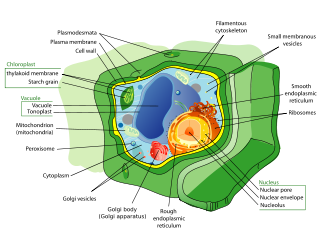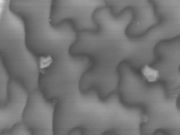Plant cell
2008/9 Schools Wikipedia Selection. Related subjects: Biology
Plant cells are eukaryotic cells that differ in several key respects from the cells of other eukaryotic organisms. Their distinctive features include:
- A large central vacuole, a sap-filled volume enclosed by a membrane known as the tonoplast maintains the cell's turgor, controls movement of molecules between the cytosol and sap, stores useful material and digests waste proteins and organelles.
- A cell wall composed of cellulose and hemicellulose, pectin and in many cases lignin, and secreted by the protoplast on the outside of the cell membrane. This contrasts with the cell walls of fungi (which are made of chitin), and of bacteria, which are made of peptidoglycan.
- Specialised cell-cell communication pathways known as plasmodesmata, pores in the primary cell wall through which the plasmalemma and endoplasmic reticulum of adjacent cells are continuous.
- Plastids, notably the chloroplasts which contain chlorophyll and the biochemical systems for light harvesting and photosynthesis, but also amyloplasts specialized for starch storage, elaioplasts specialized for fat storage and chromoplasts specialized for synthesis and storage of pigments. As in mitochondria, which have a genome encoding 37 genes plastids have their own genomes of about 100-120 unique genes and probably arose as prokaryotic endosymbionts living in the cells of an early eukaryotic ancestor of the land plants and algae.
- Cell division by construction of a phragmoplast as a template for building a cell plate late in cytokinesis is characteristic of land plants and a few groups of algae, notably the Charophytes and the Order Trentepohliales
- The sperm of Bryophytes have flagellae similar to those in animals, but higher plants, (including Gymnosperms and flowering plants) lack the flagellae and centrioles that are present in animal cells.
Cell types
- Parenchyma cells are living cells that have diverse functions ranging from storage (storage cell) and support to photosynthesis (chlorenchyma cell) and phloem loading (transfer cell). Some parenchyma cells, as in the epidermis, are specialized for light penetration and focusing or regulation of gas exchange. Parenchyma cells have thin primary walls which serves for the mediation of materials, and their cytoplasm is responsible for a wide range of biochemical functions such as nectar secretion, or the manufacture of secondary products that discourage herbivory. Apart from the xylem and phloem in its vascular bundles, leaves are composed of parenchyma cells. Parenchyma cells which contain many chloroplasts and are concerned primarily with photosynthesis are called chlorenchyma cells.
- Collenchyma cells - Collenchyma cells are also alive at maturity and have only a primary wall. These cells mature from meristem derivatives. They pass briefly through a stage resembling parenchyma, however they are destined to differentiate into collenchyma, and this fact is quite obvious from the very earliest stages. Plastids do not develop and secretory apparatus (ER and Golgi) proliferates to secrete additional primary wall. The wall is most commonly thickest at the corners, where three or more cells come in contact and thinnest where only two cells come in contact, though other arrangements of the wall thickening are possible.
Pectin and hemicellulose are the dominant constituents of collenchyma cell walls which may contain as little as 20% of cellulose in Petasites. Collenchyma cells are typically quite elongated, and may divide transversly to give a septate appearance. The role of this cell type is to support the plant in axes still growing in length, and to confer flexibility and tensile strength on tissues. The primary wall lacks lignin that would make it rigid and brittle, so this cell type provides what could be called plastic support. Support that can hold a young stem or petiole into the air, but in cells that can be stretched as the cells around them elongate. Stretchable support (without elastic snap-back) is a good way to describe what collenchyma does. Parts of the strings in celery are collenchyma.
- Sclerenchyma cells - Sclerenchyma cells (from the Greek skleros, hard) are hard and tough cells with a function in mechanical support. They are of two broad types - sclereids or stone cells and fibres. The cells develop an extensive secondary cell wall that is laid down on the inside of the primary cell wall. The secondary wall is impregnated with lignin, making it hard and impermeable to water. Thus, these cells cannot survive for long as they cannot exchange sufficient material to maintain active metabolism. Sclerenchyma cells are typically dead at functional maturity, and the cytoplasm is missing, leaving an empty central cavity.
Functions for sclereid cells include discouraging herbivory (hard cells that give leaves a gritty texture, or rip open digestive passages in small insect larval stages), protection (a solid tissue of hard sclereid cells form the pit wall in a peach and many other fruits). Functions of fibres include provision of load-bearing support and tensile strength to the leaves and stems of herbaceous plants. Sclerenchyma fibres are not involved in conduction, either of water and nutrients (as in the xylem) or of carbon compounds (as in the phloem), but it is likely that they may have evolved as modifications of xylem and phloem initials in early land plants.
Tissue types
The major classes of cells differentiate from undifferentiated meristematic cells (analogous to the stem cells of animals) to form the tissue structures of roots, stems, leaves, flowers and reproductive structures.
Xylem cells are elongated cells with lignified secondary thickening of the cell walls. The bryophytes lack true xylem cells, but the sporophytes of bryophytes have a water conducting tissue known as the hydrome that is composed of elongated cells of simpler construction. Xylem cells are specialised for conduction of water, and first appeared in plants during their transition to land in the Silurian period (see Cooksonia). They characterise the vascular plants or Tracheophytes. Xylem tracheids are pointed, elongated xylem cells that have continuous primary cell walls. The ferns and other pteridophytes and the gymnosperms only have xylem tracheids, while the angiosperms also have xylem vessels. Vessel members are hollow xylem cells aligned end-to-end, without end walls or perforate that may be assembled into long continuous tubes.
Phloem is a specialised tissue for food conduction in higher plants. The bryophytes lack phloem, but moss sporophytes have a simpler tissue with analogous function known as the leptome. Phloem consists of two cell types, the sieve tubes and the intimately-associated companion cells. The sieve tube elements lack nuclei and ribosomes, and their metabolism and functions are regulated by the adjacent nucleate companion cells. Sieve tubes are joined end to end with perforate end-plates between known as sieve plates, which allow transport of photosynthate between the sieve elements. The companion cells, connected to the sieve tubes via plasmodesmata, are responsible for loading the phloem with sugars.
Plant epidermal cells are specialised parenchyma cells covering the external surfaces of stems and other aerial organs and roots. The epidermal cells arise from the superficial layer of cells known as the tunica that covers the plant shoot apex, whereas the cortex and vascular tissues arise from innermost layers of the shoot apex. The epidermis of roots originates from the layer of cells immediately beneath the root cap.
The epidermis of all aerial organs, but not roots, is covered with a cuticle made of waxes and the polyester cutin. Several cell types may be present in the epidermis. Notable among these are the stomatal guard cells, glandular and clothing hairs or trichomes, and the root hairs of primary roots. In the epidermis of most plants, only the guard cells have chloroplasts. The epidermal cells of the primary shoot are thought to be the only plant cells with the biochemical capacity to synthesize cutin.
Parts
- Cell membrane
- Cell wall
- Plasmodesma
- Vacuole
- Tonoplast
- Crystal
- Plastids
- Chloroplast
- Leucoplast
- Chromoplast
- Golgi Complex
- Ribosome
- Endoplasmic reticulum
- Mitochondrion
- Microtubule
- Microfilament
- Lysosome
- Microbody
- Cytoplasm
- Nucleus
- Nuclear envelope (membrane)
- Nuclear pore
- DNA
- Chromatin
- RNA
- Messenger RNA
- Transfer RNA

